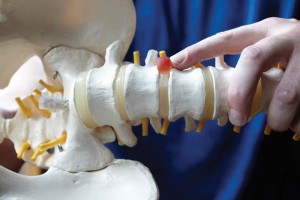 Commonly called “herniated disc” or “ruptured disc” (or misleadingly called “slipped disc”), a disc prolapse is one of the common conditions we treat. The spinal column is made up of a number of bones called vertebrae.
Commonly called “herniated disc” or “ruptured disc” (or misleadingly called “slipped disc”), a disc prolapse is one of the common conditions we treat. The spinal column is made up of a number of bones called vertebrae.
Between these vertebrae are discs which prevent the bones from rubbing against each other during movement and act as shock absorbers during impact. In the lumbar spine (lower back), the discs are composed of a fibrous outer layer and a gel-like inner layer. When the outer layer becomes worn through overuse or injury, the inner layer can leak or “prolapse” out of the disc and cause pain.
Sometimes all it takes is a sudden and forceful movement (such as bending or lifting) to put too much strain on an already weakened disc and cause severe pain. If the prolapsed substance touches a nerve, pain, weakness and reduced sensation can be felt along the nerve, usually down the buttock or leg. This is known as sciatica.
Staying active during the acute stages of lower back pain is preferred over bed rest, as long as the activity does not aggravate the pain. An early visit to your physiotherapist is critical in assisting the body in repairing the disc for pain relieving strategies.
A thorough physiotherapy assessment should include various neurological, orthopaedic and specialised test. Physiotherapy treatment includes pain-relieving strategies such as heat and soft-tissue massage, progressing onto joint mobilisation and exercises where possible. Getting the spinal joints moving will reduce stiffness, restore mobility and promote healing of the damaged disc. Specific stretching and strengthening exercises to increase mobility and muscle strength and prevent further deterioration of the disc will follow.
Once healing begins to take place, a tailored exercise program that suits individual needs and lifestyle should be prescribed. Core strengthening exercises that tighten the abdominal wall are usually recommended to promote good posture and restore normal function. Education in proper body mechanics such as lifting, bending, work habits etc, is vital in preventing a recurrence of the injury.
